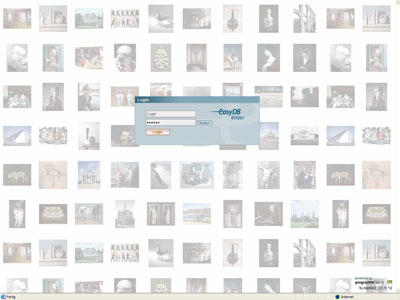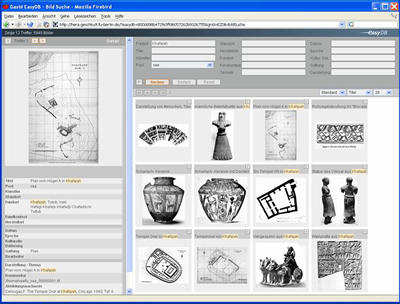Media Center / Easy DB
Several institutes of the Department of History and Cultural Studies initiated a project in Summer 2003 to assemble a common image database. The Institutes for Near Eastern Archaeology and Near Eastern Studies have been part of this from the beginning.
The project’s goal is to assemble the image collections (primarily consisting of slides) of the individual institutes into one easily accessible database, which will be available for lectures, seminars, and study. The database includes clear and quick image management, keyword indexing, and a customized search engine, as well as the ability to work with selected images on- or off-line and to use them for presentations.
After a thorough advisory and testing phase of various software and hardware solutions, the browser-based database “easyDB” was chosen, as it allows for images to be viewed, collected, edited, and presented from any location via the internet.
Mozilla-Firebird, Mozilla-Firefox, or Internet Explorer 6 are recommended for using the database.
The image database can be found at this address: http://easydb.geschkult.fu-berlin.de. You can request an account here.
Fig.1: easyDB Login

The database manages the image collections of the participating institutes in different pools. The visual media for the Institutes for Near Eastern Archaeology and Near Eastern Studies are collected in the pools “vaa” and ”ao”.
Fig. 2: easyDB Search Engine

The database offers numerous search possibilities. Free-text search allows for search by keyword in all data sets and fields, while searches can be narrowed by selecting particular pools. For even more specific criteria, the advanced search feature can be used. For example, images can be located according to chronological period, geographical location, or literature in which they were originally published. Search results can also be further narrowed through the combination of various keywords.
The search results can be collected in a file for presentations and saved.
The database is currently under construction.
The Institutes for Near Eastern Archaeology and Near Eastern Studies have a workplace for the digitalization of visual media that includes desktop and notebook computers and slide- and A3 flatbed scanners.
The focus of the digitalization work has been the conversion of the slide library’s ca. 25,000 slides and their associated keywords. In addition, the Institutes have access to numerous collections of images from both research projects and private individuals.
The digitalization process follows fixed guidelines. The selected media are first scanned, tagged, and saved. The image files are then incorporated in the easyDB database. In the final step, information about the images is documented with details on the type of artifact, origin, archaeological context, chronological assignment, technical aspects, material, and history of publication.
Because the inventory of the slide library is already systematically organized, it can be recorded in the database with the same consecutive numbering. When the quality of the slides does not meet the required standards, individual slides are reworked or replaced through other media.
The keyword indexing of the visual media in the database sometimes requires additional or further details about an image than the information collected in the long history of the slide library.